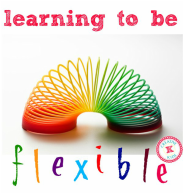 Flexibility (noun): The quality of bending easily without breaking
Flexibility (noun): The quality of bending easily without breaking
Flexibility is an important life skill. However, sometimes flexibility doesn’t come naturally and must be learned. Unlike other skills, flexibility isn’t something that can always be seen physically and is more abstract, sometimes making it challenging to know when and how to teach. Because of this, we need to make it a point to notice whenever our children are being flexible and provide consistent reinforcement! For example, a child might struggle with wanting pieces of a game set up the same way every time the game is played (i.e. all pieces in a straight line, lined up by color, etc.). As teachers and parents, we could start by prompting changes in routines/actions and reinforcing every time even the slightest hint of flexibility is detected, working to increase flexibility and gradually fade reinforcement. The end goal would be to have the child be okay with and not engage in challenging behaviors during changes that occur naturally or that another individual initiates. We want our children to have the delicate balance of being able to gracefully accept changes (bend) while still maintaining a sense of assertiveness for themselves (without breaking).
Written by Mary Hanks, M.Ed., BCBA